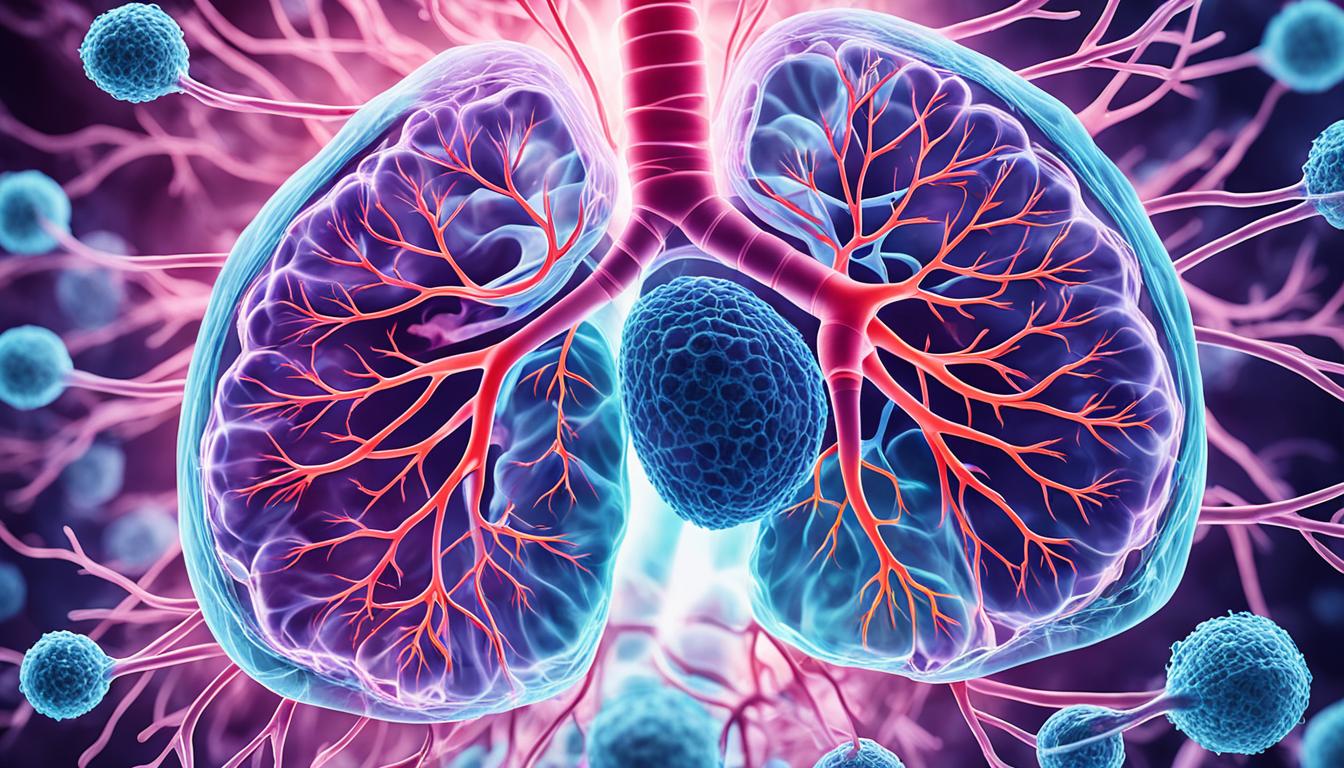Atelectasis means a lung has partly or fully collapsed. The air sacs in the lungs shrink or fill with fluid. This causes issues like shortness of breath and chest pain. Things that can lead to atelectasis are problems with breathing, chest surgeries, lung growths, chest injuries, and breathing in things that shouldn’t be inhaled.
When a doctor looks into atelectasis, they check the patient’s health history and use tests like X-rays and CT scans. They might also check how much oxygen is in the blood and look inside the chest with a camera (bronchoscopy). The treatment for atelectasis will change based on what’s causing it. This could include taking medicine or sometimes even needing surgery. Lately, stem cell therapy is getting more attention as a possible way to treat lung collapse.
Key Takeaways:
- Symptoms of atelectasis include shortness of breath, chest pain, and difficulty breathing
- Causes of lung collapse can include respiratory problems, thoracic surgery, lung tumors, chest trauma, and inhaling foreign matter
- Diagnosis of atelectasis involves reviewing the patient’s medical history and conducting various tests
- Treatment for atelectasis depends on the underlying cause and can range from medication to surgery
- Stem cell therapy has shown promise as a treatment option for lung collapse
Symptoms of Atelectasis
Atelectasis shows different signs based on how bad and where the lung has collapsed. Knowing these signs helps prompt treatment to avoid further issues.
Shortness of breath is a key sign. When lung tissue collapses, it limits oxygen in the blood. This leads to feeling like you’re out of breath and finding it hard to breathe.
Chest pain can also be a sign. The pain feels sharp and gets worse with deep breaths or a cough.
Difficulty breathing is another symptom. It might feel like your chest is tight or that your lungs can’t fully open.
Sometimes, atelectasis has no symptoms, especially with small lung collapses. But, it’s crucial to still watch for signs. See a doctor if any of the key symptoms are there. They might point to a bigger health issue that needs attention.
Understanding atelectasis signs can help anyone take care of their lungs better. This knowledge encourages getting help quickly if needed.
| Symptoms of Atelectasis |
|---|
| Shortness of breath |
| Chest pain |
| Difficulty breathing |
Causes and Diagnosis of Atelectasis
Atelectasis is a term for when a lung partially or fully collapses. Several things can mess with the lung’s job and cause this. It’s key to figure out these causes to help treat and manage atelectasis.
Intrinsic Airway Obstruction
Intrinsic airway obstruction is a leading cause, especially in kids. It’s when the airways inside the lungs get blocked or narrow. Asthma, bronchiolitis, and cystic fibrosis can make this worse, leading to atelectasis.
Extrinsic Compression
Extrinsic compression is when something outside presses on the lungs, causing them to collapse. Big lymph nodes, tumors, or masses in the chest can squeeze the lungs. This pressure can lead to atelectasis.
Diaphragmatic Dysfunction and Hypoventilation
The diaphragm is vital for breathing right. If it doesn’t work well, after surgery or in some diseases, it can affect air going into the lungs. This can cause airless spots and atelectasis.
Increased Surface Tension
Too much force between liquid molecules in the alveoli can stop the lungs from fully expanding. This is called too much surface tension. It can make atelectasis happen by preventing proper lung inflation.
Diagnosis of Atelectasis
Healthcare pros check patient history and do physical exams. They also use tests like X-rays and CT scans.
- X-rays: Gives doctors a picture of the inside so they can see the collapse.
- CT scans: More detailed x-rays to see what’s pressing on the lungs.
- Oxygen measurement: Checks how well your lungs are working.
- Thoracic ultrasound: Shows images of your lungs and what’s around them clearly.
- Bronchoscopy: A close look at your airways with a tiny camera.
Diagnosing atelectasis is about figuring out what’s causing the lung to collapse. Knowing the cause helps make the right plan to treat it.
Treatment and Stem Cell Therapy for Atelectasis
Treating atelectasis depends on the cause and can need different methods. The approach varies by how bad it is. For mild cases, techniques like deep breathing, changing your position to help drain your chest, and gentle tapping on your back can make the lung re-expand. This way, you help air move better, and mucus can come out. In severe cases, like when something is stopping the air, a surgery or bronchoscopy might be needed to clear the blockage.
Breathing treatments are also key in atelectasis care. They can include using special medicines in a mist that you breathe in. These drugs can open your airways and cut down on swelling, making it easier to breathe. Make sure to use them as your doctor says to get the best results.
In recent years, using stem cells for atelectasis has shown a lot of hope. Stem cells can help repair damaged lung tissue and heal it. This new treatment could significantly better lung function and life quality for those with atelectasis. Doctors get these stem cells from places like your bone marrow or fat tissue, and they inject them into your lung’s problem area.
If atelectasis is a diagnosis you’ve been given, seeing a healthcare provider is crucial. They can figure out the right treatment plan for you. With new technology and the use of stem cell therapy, there’s a chance for better results and a better life for those with lung collapse.

